As an experienced woodworker, I am always in search of tools that can assist me in crafting or other delicate projects. Throughout the years, I have used numerous nail guns, one of which is a 23 gauge air nailer. It is quite impressive. This exceptional power tool has become vital to my workshop.
The 23 gauge air nailer, also known as the 23 gauge pneumatic nailer or pin nailer, is a pneumatic tool that uses an air compressor to shoot ultra-thin nails or pins. A 23 gauge headless pin nail is small in size. 23 gauge nail guns are available in both air or pneumatic version and cordless version. Here I only focused on 23 gauge air nailers.
Unlike brad nailers or finish nailers, a 23 gauge air pin nailer uses headless nails. This is why they leave almost invisible holes. It makes them ideal for woodworking or light trim work. A 23 gauge pneumatic pin nailer allows a delicate touch that reduces damage to fragile or delicate materials.
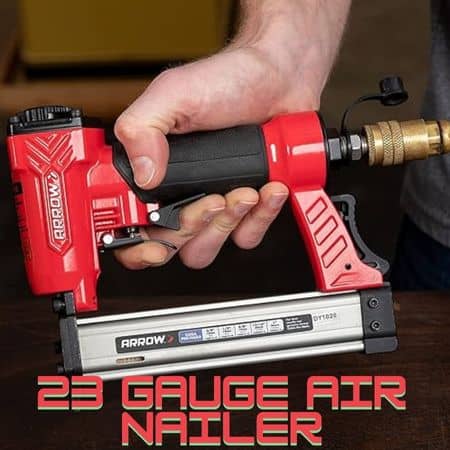
Requirements for Using a 23 Gauge Air Nailer
A 23 gauge air pin nailer is ideal for lightweight tasks such as trim installation, cabinetry, molding, and other delicate materials. However, to achieve maximum performance, this tool must meet air compressors and safety requirements.
Below, I have outlined some key requirements you need to run a this air nailer effectively.
Air Compressor Requirements
- 23 gauge air nailer means pneumatic nailer. It requires air compressors to function properly.
- The air compressor needs to deliver an air pressure minimum of 70 PSI to a maximum of 100 PSI.
- Require an airflow range between 0.5 – 1.5 CFM (CFM – Cubic Feet Per Minute). A low CFM rating is effective because these nailers do not consume a lot of air.
- The tank size will vary based on the projects. 1-2 gallon tank for lightweight usage, 4-6 gallon tank for professional and uninterrupted operation.
Pin Nail Requirements
- 23 gauge air nailers drive thin pins. These pins are headless and almost invisible once driven.
- Pin nail length should range from 1/2 inches to 1-3/8 inches. Some models can accommodate up to 2 inches length pins.
- Use steel or galvanized nails to ensure longer durability.
- Choose stainless steel pin nails if you opt for working outside
Tool Adjustments
- To ensure optimal performance a 23 gauge air nailer should include these key requirements:
- Adjustable depth control to permit you to fire nails without damaging the material.
- Ensure a better anti-jam release mechanism to prevent nails from getting stuck.
- Ensure exhaust vent control for air redirecting from the operator for a safer working environment.
- Some models offer sequential triggering options, which means one nail per trigger pull. Moreover, some other models deal with bump mode for fast nailing.
Maintenance Requirements
- To keep the nailers and air compressors in tip-top condition, you have to abide by these mentioned maintenance requirements:
- Need enough lubrication. Before each use, pour a few drops of tool oil into the air inlet of the nail gun.
- Daily air compressor tank draining is a must to prevent condensation buildup. It can cause rust.
- Clean the nailer after each use to remove debris or dust. It will help prevent nail jamming.
- Check the seals and fittings appropriately. Regularly check if there are any loose connections or air leaks.
Air Hose Requirements
- For a 23 gauge air nailer, an air hose diameter of 1/4 inches is sufficient.
- To prevent pressure drops, keep hoses short (under 50 feet).
- A dedicated power outlet is used for the air compressor power supply. It will help avoid voltage drops.
Environmental Conditions & Storage
- A 23 gauge air pin nailer operates well in temperatures between 4°C to 43°C (40°F to 110°F).
- Do not use it in frozen temperatures, as compressed air can build moisture inside the tool and cause it to jam.
- Store the nailer and air compressor in a clean and dry area to avoid erosion and rust.
Relations Between Air Compressor & A 23 Gauge Air Nailer
A 23 gauge air nailer means a 23 gauge pneumatic pin nailer. A pneumatic pin nailer always needs an air compressor to provide compressed air. It drives thin or headless nails into delicate materials precisely and smoothly.
While the nail gun is ideal for precision, its performance depends on the air compressor attached to it. Choosing the right air compressor is essential to ensure the air nailer’s performance.
Air Pressure Requirements
While pairing a 23 gauge air nailer with an air compressor you have to measure whether the air compressor can supply the right air pressure. Maximum models of a 23 gauge air pin nailer typically require an operating pressure of 70-100 PSI.
The PSI (Pounds Per Square Inch) rating indicates the air pressure required by the nail gun. Running the compressor below the range will result in incomplete nail driving or misfire. Similarly, operating the compressor above the recommended PSI range will damage the tool and cause wood splitting.
Apply the regulator on the compressor to set the accurate PSI according to the nailer’s requirements. My pro tip would be to stick between 80-90 PSI to balance power and precision.
Air Volume (CFM) Demands
In addition to air pressure air volume delivered by the compressor is measured in CFM (Cubic Feet Per Minute). It is an important factor for a this nailing tool.
A pneumatic 23 gauge pin nailer consumes less air compared to larger tools, such as framing nail guns. They usually require low CFM demands ranging between 0.5 – 1.5 CFM.
An adequate level of CFM supply ensures uninterrupted, steady, and consistent performance. Insufficient air volume will break the consistency and may pause between firing.
Matching Air Compressor Capabilities
While choosing an air compressor to power your 23 gauge air nailer, it is important to carefully check the nailer’s specifications. Select a compressor that not only meets but exceeds the suggested pressure and airflow needs. This will give you a comfortable performance margin. You can work without any buffer.
Many nail gun manufacturers provide nail gun and air compressor combo kits. These are designed for optimal consistency. This combo offer eliminates the uncertainty and provides a smooth high-performance combination just after pairing.
Air Hose Size & Connections
In addition to the air compressor, air hoses, and fittings are also very impactful in air delivery systems. The recommended hose diameter and length with high-quality secured connections help you maintain the necessary airflow to the tool.
while choosing an air compressor for your 23 gauge air nailer, carefully consider the air pressure, volume, and delivery system. This will elevate your woodworking project to new levels with reliability and efficiency.
Key Air Compressor Specifications for 23 Gauge Pin Air Nailer
| Specifications | Purpose | Recommended for 23 Gauge Air Pin Nailer |
| PSI | Air pressure is needed for the nailer to operate | 70-100 PSI |
| CFM | Air volume output is required to operate the tool | 0.5-1.5 CFM |
| Tank Size | Total amount of air the compressor can store | 1-2 Gallons (Small Tasks); 4-8 Gallons (Frequent & Larger Tasks) |
| Duty Cycle | Percentage of time an air compressor can run at a time | A 50-100% duty cycle is perfect for flawless frequent use |
Air Compressor Types: For Your 23 Gauge Air Nailer
Pancake Air Compressor
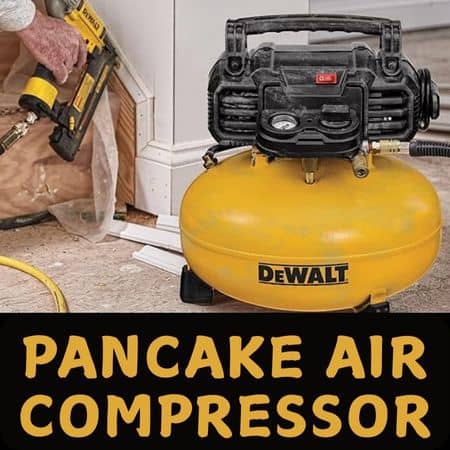
| Specifications | Facts | Pros | Cons |
| Tank Dimension | 3-6 gallons | Lightweight design | Not perfect for heavy-duty and larger tasks. |
| CFM | 2.5-3.5 CFM at 90 PSI | Swift recovery times between duty cycles | Loud compared to some other models |
| Weight | 20-35 lbs | Easy to move and you can transport to your work place | Limited air storage for uninterrupted use |
| PSI Range | 90-150 | Great for light-duty tasks | |
| Portability | Lightweight, movable, easy to carry | ||
| Noise Level | 75-85 decibels |
Hot Dog Air Compressor
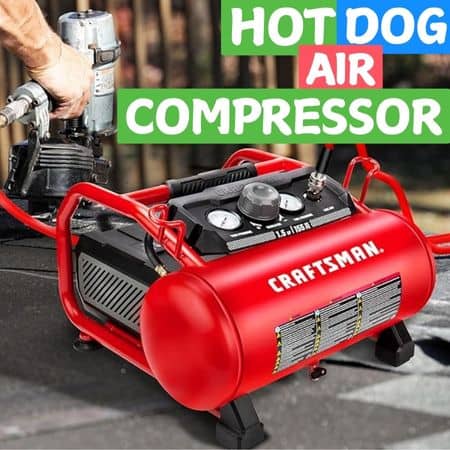
| Specifications | Facts | Pros | Cons |
| Tank Dimension | 4-8 gallons | Tank size is slightly larger than pancake compressor | Heavier than pancake models |
| CFM | 2.5-4 CFM at 90 PSI | Portable and easy to store | Noisy |
| Weight | 35-50 lbs | Run for a longer time without frequent refills | Not perfect for indoor use |
| PSI | 90-150 | Perfect for small workshops | |
| Portability | Moderate | Appropriate for multiple pinning tasks | |
| Noise Level | 75-85 decibels |
Twin-Stack Air Compressor
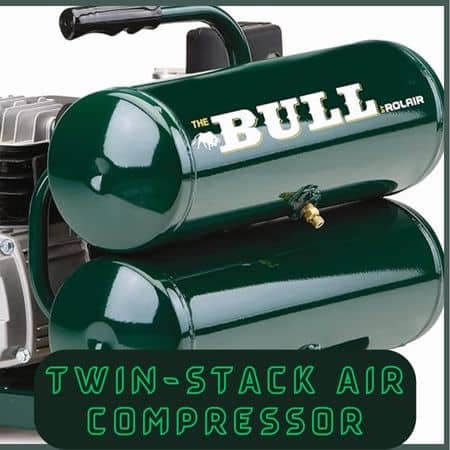
| Specifications | Facts | Pros | Cons |
| Tank Dimension | 4-6 Gallons (Dual Tanks) | Higher air capacity | Heavier than other types of compressor |
| CFM | 3-4 CFM at 90 PSI | Better for larger projects and tasks | Not suitable for small 23 gauge nailers |
| Weight | 45-60 lbs | Consistent pressure | Less portable |
| PSI | 90-150 | No frequent refills | |
| Portability | Portable but weightier | More stable air pressure | |
| Noise Level | 75-90 decibels | Suitable for multiple tasks |
Portable Electric Air Compressor
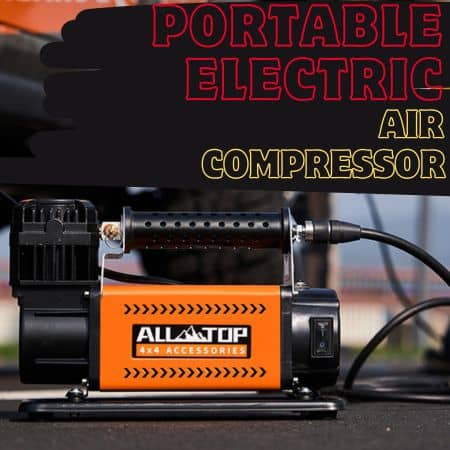
| Specifications | Facts | Pros | Cons |
| Tank Dimension | 1-3 Gallons | Highly portable | Inappropriate for large-scale jobs |
| CFM | 1-2 CFM at 90 PSI | ideal for indoor use | frequent refills needed |
| Weight | 10-20 lbs | perfect for quick, light projects | Not suitable for continuous nailing |
| PSI | 80-100 | Easy to store | |
| Portability | Lightweight and high portability | ||
| Noise Level | 60-75 decibels |
Stationary Air Compressor
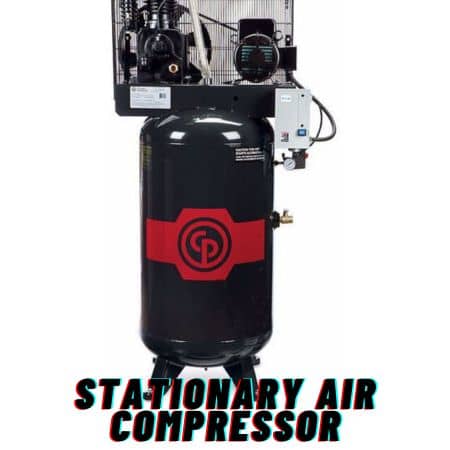
| Specifications | Facts | Pros | Cons |
| Tank Dimension | 10-80 Gallons | Larger tank size | Bulky and immobile |
| CFM | Above 5 CFM at 90 PSI | Constant air pressure | Needs dedicated space |
| Weight | Above 100 lbs | Ideal for professional woodworkers or contractors | Not suitable for small nailers |
| PSI | 175 PSI or Higher | Designed especially for industrial or factory use | Requires regular maintenance after use |
| Portability | Not portable | supports multiple tools together | Requires professional installation |
| Noise Level | 85-95 decibels |
Wheelbarrow Air Compressor
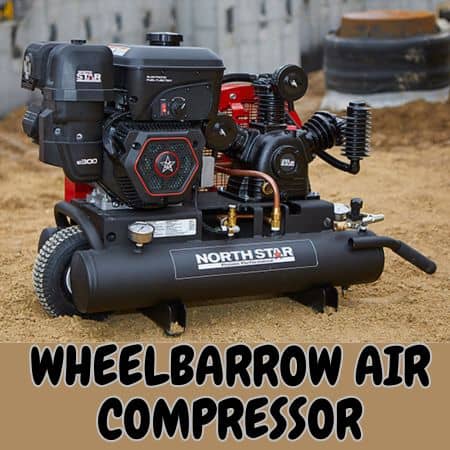
| Specifications | Facts | Pros | Cons |
| Tank Dimension | 8-12 Gallons | Easy to move | Bulky and heavy |
| CFM | 4-6 CFM at 90 PSI | Can handle large tools | Requires extra maintenance after use |
| Weight | 70-100 lbs | Moderate airflow needs | |
| PSI | 125-150 | Easy portability | |
| Portability | portable | ||
| Noise Level | 90 or Above decibels |
Comparison Table of Air Compressors for 23 Gauge Air Nailer-At A Glance
| Compressor Type | Tank Dimension | Maximum PSI | CFM at 90 PSI | Portability | Best Use |
| Pancake | 3-6 Gallons | 90-150 | 2.5-3.5 | High | Light nailing |
| Hot-Dog | 4-8 Gallons | 90-150 | 2-4 | Moderate | Workshops, small repairs |
| Twin-Stack | 4-6 Gallons | 90-150 | 3-4 | Moderate | Professional nailing |
| Portable Electric | 1-3 Gallons | 80-100 | 1-2 | Very High | DIY, crafts, indoor use |
| Stationary | 10-80 Gallons | 175 or Above | 5 or Above | Low | Industrial applications |
| Wheelbarrow | 8-12 Gallons | 125-150 | 4-6 | Moderate | Roofing, framing jobs |
Other Components of A 23 Gauge Air Nailer
Understanding the components of a 23 gauge air pin nailer is essential for both beginners and pros. This will help you operate the tool smoothly and effectively.
Body or Frame
The main body of the air nailer is usually made from lightweight aluminum or magnesium. It secures the internal components together to ensure durability. This body frame maintains a lightweight design for easy handling.
Magazine
The magazine is a key component that holds 23 gauge nails. The most common type of magazine is straight magazine. It holds the pin nails aligned in a straight line. Depending on the model, it can easily place 100-200 nails together.
Safety Tip or Nosepiece
The nosepiece is the front component of the gun where the pin nails exit. It typically has a non-marring safety tip, which prevents delicate surface damage.
It must be pressed firmly against the work surface to activate the nailer’s trigger safely. Some models have removable tips, for simple cleaning and replacement.
Piston or Driver Blade
Inside the nailer, the driver blade connects to the piston. When you apply pressure the piston will push the driver blade forward to fire the nail into the material.
It Converts air pressure into mechanical force to drive the nails smoothly and it returns to its previous original position after each shot.
Air Inlet Port
The air inlet port links the nailer to the air compressor by an air hose. It supplies the compressed air for the nail gun to operate.
The standard size is 1/4” or 0.25” NPT (National Pipe Taper). This size is compatible with most air hoses.
Exhaust Vent
The exhaust vent lets the air exit the tool firing nails. Some models come with an adjustable vent to direct air away from the user.
It allows to release of used air to prevent back pressure. Moreover, It enhances comfort for the user by directing air away from the face or hands.
Depth Adjustment Dial
Some models of this tool come with a depth-adjustable mechanism to adjust how deep the nail drives into a certain material.
This component ensures nails are driven consistently without harming the surface. Additionally, it allows proper nail placement depending on the task.
Anti-Jam Mechanism
The anti-jam mechanism is designed to stop nails from getting stuck while firing. It makes the chamber clean to reduce downtime and fire easily.
Some models have a quick jam-release nose for even faster jam-clearing.
Spring Mechanism
The spring mechanism inside the magazine pushes the nails forward toward the nosepiece. This mechanism ensures smooth feeding.
Moreover, it allows the pins are always properly aligned for the next shot. It helps prevent double feeding or misfeeds.
Handle & Grip
The handle is often equipped with rubberized or ergonomic grips. You will feel comfortable for prolonged use.
It minimizes hand fatigue issues. Also improves hand control and prevents sudden slipping.
Air Regulator
Some tools like the 23 gauge air nailer have a built-in air regulator to adjust the pressure you need without changing the air compressor settings.
It fine-tunes the air pressure properly to match it with various materials. It allows you to prevent overnailing.
Belt Hook
Some air nailers come with an attached belt hook for added convenience. This allows the woodworkers to hang the nailer on a tool belt when not in use.
The belt hook can be repositioned to either side of the tool for left-handers and right-handers both.
Trigger Lock
A trigger lock is a safety component that prevents accidental nail firing when the tool is not in use.
It offers an extra layer to increase safety on job sites. It will prevent accidental discharge when you transport and maintain it.
Seals & O-Rings
Seals & O-rings are essential internal components that prevent air leaks. These components enhance the smooth operation of the pneumatic system.
They maintain consistent air pressure and need regular inspection and replacement to avoid performance problems.
Pros & Cons – 23 Gauge Air Nailer
| Attributes | Pros | Cons |
| Surface Damage | Invisible hole size; reduces finishing work with wood fillers | Pins offer too small holding power. |
| Material Compatibility | Ideal for delicate trimming and softwood | Not ideal for heavy-duty wood or thick pieces |
| Appearance | Invisible pinholes provide a seamless and aesthetic finish | Difficult to notice whether the pin was properly inserted |
| Weight & Ergonomics | Lightweight and easy to use for extended periods | Limited power and pin size |
| Versatility | Useful for trimming, molding, and crafts | Not for structural or load-bearing tasks |
| Portability | Compact, and easy to transport | Requires an air compressor for operation |
| Pin Size & Strength | Prevents splitting of delicate materials | Pins offer minimal holding power |
| Safety Considerations | Low recoil and easy-to-handle | Pins can be hard to see, posing a safety risk |
| Usage Environment | Ideal for indoor projects | Not suitable for outdoor use or moisture |
Final Words on 23 Gauge Air Nailer
The 23 gauge air nailer is a vital tool for those who value precision and detailing in woodworking, trim installation, and delicate crafts. It can drive tiny 23 gauge pin nails without damaging fragile materials. The small 23 gauge pin nails, make almost invisible nail holes on the wood surface. It reduces the need for putty or wood filler. It will give you an aesthetic finish.
This pneumatic nailer is not designed for heavy-duty tasks. The pins do not have enough required strength for structural applications. It is unsuitable for framing, flooring, and heavy outdoor projects. This air nailer comes with pneumatic power. You need a compatible air compressor for uninterrupted performance.
If you frequently work on indoor projects like crown molding, photo frames, trimming, or fine furniture, this air nail gun is your go-to tool. If you want to do heavy work then you need lower gauge air nailers, like 16 gauge or 18 gauge nailers. Roofing or siding nailers are also compatible with heavy-duty jobs for their power, and durability.
Investing in a high-quality 23 gauge air nailer is like a commitment to enhance the quality of your craftsmanship. My final thoughts are to choose tools wisely, maintain them diligently, and use them safely to ensure professional results in your woodworking jobs.
FAQs – 23 Gauge Air Nailer
Q: What is a 23 gauge air nailer used for?
Ans: A 23 gauge air nailer used for:
- Crown molding,
- baseboard trimming,
- Furniture detailing,
- Picture frames,
- Veneer and small crafts
Q: What are the safety requirements I need while using a 23 gauge air nailer?
Ans: The safety requirements you need while using a 23 gauge air nailer are given below:
- Ensure safety glasses or goggles to protect your eyes from flying debris and waste.
- Use hand gloves
- Do not place your fingers on the nail path.
- Disconnect the air compressor while not in use.
Q: Can a 23 gauge air nailer work without glue?
Ans: Yes, you can use glue or adhesives for added strength. Glue and pins together will create a strong secure bond. However, using glue is not enough for larger projects.
Q: What materials can a 23 gauge air nailer work with?
Ans: These below-mentioned materials are ideal:
- Softwoods like pine, and cedar
- Particle boards like MDF, and
- Thin plywood
Q: How often should I maintain my 23 gauge air nailer?
Ans: Here I have mentioned some effective ways of your 23 gauge air nailer maintenance:
- Lubricate the tool regularly,
- If necessary use air tool oil,
- Clean the exhaust ports and
- Clear the air intake,
- Inspect worn-out O-rings and replace them to avoid sudden leaks, and
- Store the nailer in a dry place
Q: What is the key difference between 18 and 23 gauge nails?
Ans: The key difference between 18 and 23 gauge nails is their gauge thickness. It directly affects their overall mechanisms and ideal uses. 18 gauge nails are sturdy and thicker with a diameter of about 1.25 mm. 23 gauge nails are very thin with a diameter of about 0.64 mm, which is almost like a pin.
In summary, 18 gauge nails are better for medium to strength uses. 23 gauge nails are better for delicate finish work.
Keep Nailing!

